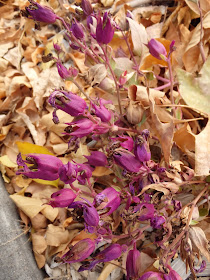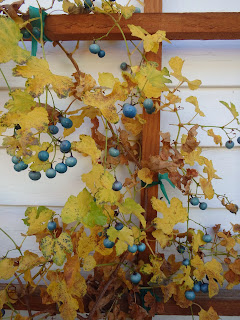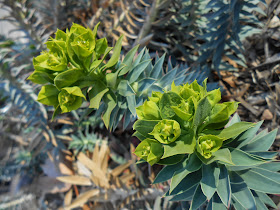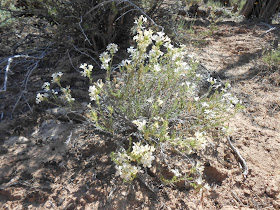This is one for the bugs. A most springs has been good for insects, too. In the past twoo weeks, bugs abound.A post to honour them.
Warning: Photos contain many shots of my unclothed left hand. This is for size.

A Mason Bee, (Osmia sp.) tries very hard against slippery plastic to stuff "bedding" for its progeny in a screw-shaft. Hey, it's easier than drilling your own hole.

An accidental hitchiker from a field collecting trip- the desert denizen, dweller-of-under-rocks, Jerusalem Cricket.

Bugs get big in the Desert.
A moth- note its very subtle forest-green flecking between the brown, the same hue as the plastic irrigaiton timer in my nursery.
Larvae of what must become a butterfly, chowing down on Paintbrush: Castilleja chromosa, on the Uncompahgre plateau.
Four "bugs" on one flower stalk. Of the Mustard Dynasty, reigning over the June desert after a good rain, Prine's Plume (
Stanley pinnata ) hosted ants who were harvesting nectar from the flowers. (A parastic wasp just crashed into my coffeecup as I write this, and flew away) I moved in to Poke at a Flower-Spider, clad in the same yellow as the flower and totally invisable. But note how some buds did not open, but are swelling obesely. These are a "gall," enclosing a small white grub, who squirmed, annoyed, in the sun when I cut open one of the parastitised buds.

\
And at the very same time, a true bug (Hemiptera- always have a triangle between their shoulders and include squahbugs, stinkbugs, leafbugs, and box-elder-bugs...) crawled onto my hand wearing that same lemon yellow camouflage. I wonder if its assymetry is intentional or a defect.
Word of the day: Glandular.
Here, the sticky, glandular-haired stems of the annual desert Unicorn plant/Devil's Claw/Double Claw
(Proboscidea parviflora) in my nursery attracts and kill gnats, whose carcasses remain on the sticky-hairy stems.
A dinosaur-looking dobsonfly/doodlebug-style creature... Note the oddly long neck for an instect.
Other creatures have made an appearance inside my apartment in larger number- one day: common house flies. One week: tiny golfball-shaped-boxy-ruddy-beetles with antlers. There were some in my seed storage box. Oh dear. Seeking specifically seeds big enough for them to be emerging from, I failed to find the seed they were attacted to, or more likely, hatching out of. The adults probably lay eggs inside of the flower- the larvae growing up in the ovary simultaneously with the maturing seed, feeding on it, and enjoying the luxury of the hard seedcoat growing around them. So, instead of morning glories germanting, there are beetles hatching. Brilliant and beautiful parastism.
I had also experienced zero germination from said Bush Morning Glory (
Ipomoea leptophylla) seed this year. I collected the seed in Las Animas County, CO, last October.
I did not figure out which seed produced them until trying to fall asleep one night, I tracked the sound of their scrambling around in my seed envelopes.
No wonder.
What clean-cut escape trap-doors, eh?
The "Red Megacerus," weighing in to the mega size of a dried pea:
Megacerus discoidus (ID courtesy of
Trina with help from the folks at
BugGuide.net) "Cerus" from "Keros" means horn, in greek, by the way. "Mega" means big. Maybe.
At once, I felt helplessly guilty for accidentally allowing some of these Southeast Colorado creatures escape on the Western Slope- until their description notes that they are also parasites to Convuluvulus arvensis- AKA Bindweed!
Godspeed to you, Megacerus!




















































